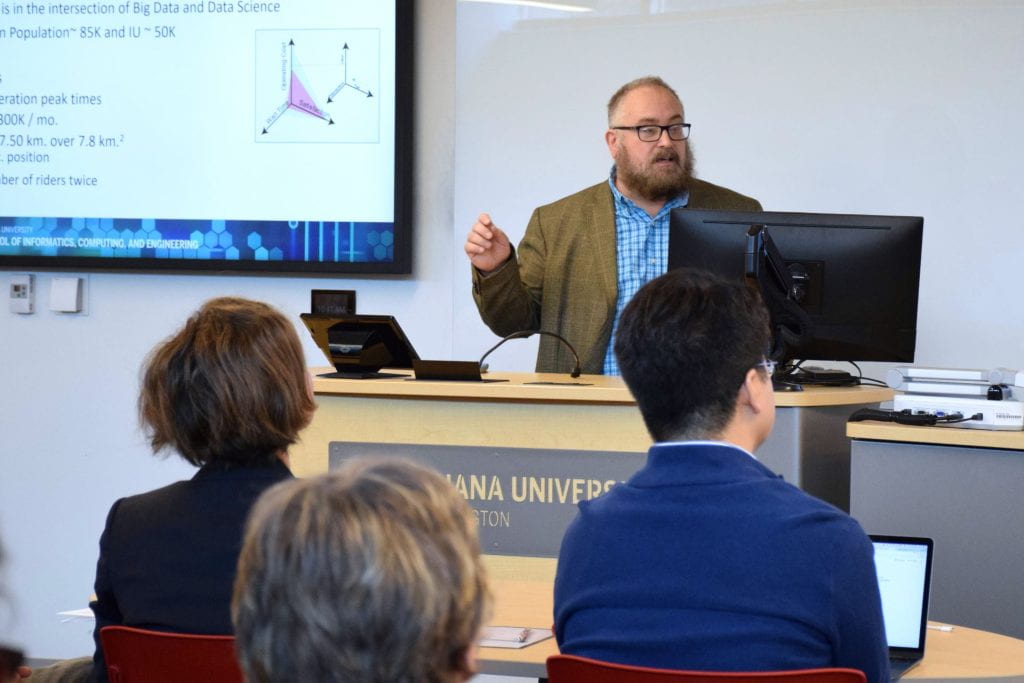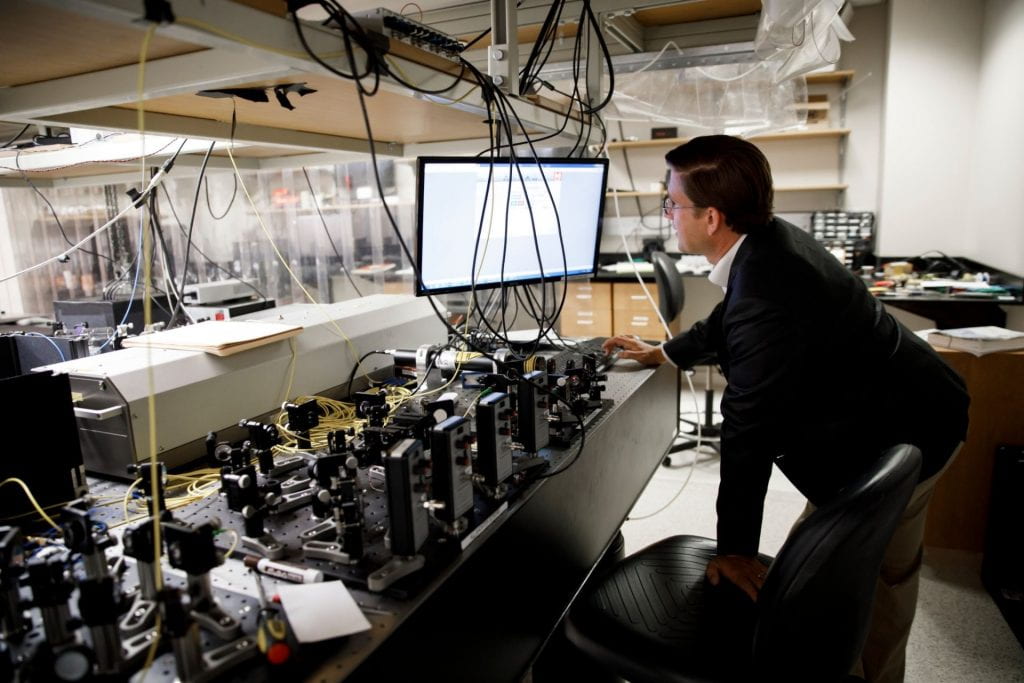An Indiana University initiative to support and advance the development of promising new technologies with potential applications in national security and defense has reached several major milestones as it approaches the end of its second year.
In late 2020, IU received a grant from the National Security Innovation Network, a program office within the U.S. Department of Defense, to launch an Academic Accelerator program. Led by IU Provost Professor of Chemistry Jeffrey Zaleski and Joe Carley, IU director for economic development, the A2 program has since engaged teams of faculty and graduate students in growing applied technology development projects with practical applications for commercial and government clients. To further this work, the program has leveraged IU’s research expertise in high-performance computing, artificial intelligence and machine learning, and quantum information science; the university’s experience in supporting and guiding successful new business ventures; and its strong partnerships with Indiana’s innovation defense ecosystem, including Naval Surface Warfare Center (NSWC), Crane Division.

“Jeff and I believed strongly that there would be value in funding and supporting faculty to develop applied technologies through the earliest lifecycle stages,” Carley said. “Similar to the startup world, the earliest stages of applied research often have the scarcest resources, as many funders want to see a proof of concept before providing support.”
Though the program coordinators anticipated several positive outcomes early in the program’s lifecycle — including the development of new project sponsors and contract vehicles — they are bullish about the timing and potential impact of A2’s recent milestones, which are described below. The A2 has demonstrated this progress at a time when the defense sector of the 11-country Indiana Uplands region, which includes Monroe County, home to IU’s Bloomington campus, is experiencing sizeable growth. Its milestones also come as IU initiates its new IU 2030 strategic planning process, which aims to help establish stronger university alignment with areas the state has targeted for investment and growth, including quantum information science, AI and machine learning.
A solution for smarter UAVs
One team launched by the A2, led by Mehmet “Memo” Dalkilic, a professor of computer science and director of undergraduate studies for data science at IU Bloomington’s Luddy School of Informatics, Computing and Engineering, has focused on using artificial intelligence and machine learning to create smarter unmanned autonomous vehicles.
An authority on applied AI and data science and a frequent collaborator with NSWC Crane, Dalkilic worked closely with Scott Beason, an experienced software executive and startup founder, to create a platform for quick surveying of buildings to minimize risk to warfighters. The system runs on a standard laptop and leverages new run-time data reduction techniques that Dalkilic’s group developed. It also includes object detection and collision avoidance technologies that are commonly found on other types of autonomous vehicles.
Dalkilic and Beason first developed their algorithms in a virtual environment and have now begun testing on actual drones. They believe their unique contribution to the field is in integrating state-of-the-art algorithms into a library of software code that is written to be reconfigurable to address different task and work across multiple UAV platforms.
“Because of our virtual environment, we have been able to develop novel approaches to autonomous drone navigation with limited capital expenditures,” Dalkilic said. “We have a suite of algorithms that have set us up to provide custom solutions to drone problems moving forward.”
Protecting the quantum computer
Phil Richerme, an associate professor of physics in the IU Bloomington College of Arts and Sciences, has led a second A2 team that has constructed a miniaturized quantum computer for purposes of radiation testing. In the future, quantum computers will almost certainly have important roles in high-radiation environments — especially in space — though little is known about how radiation will impact their functions. NSWC Crane is a national leader in radiation effects testing and will serve as the initial test site for the quantum computer. It was also an initial funder of this project.

Before Richerme, whose research focuses on the intersection of atomic physics and quantum information, and his team can irradiate the quantum computer, they had to first ensure that it can be moved without disrupting the function of the computer. Quantum computers operate on the atomic level and are highly sensitive to disruptions from the outside world. As such, the project will not only yield significant lessons about the effects of radiation on quantum computers, but also about miniaturizing and stabilizing them.
“This project has taken the first step in understanding the portability and resiliency of quantum computers, which will be crucial if quantum devices are to operate outside the confines of a well-controlled laboratory,” Richerme said.

Richerme’s work with NSWC Crane has also advanced a workforce development partnership between the two institutions. Kevin Goodman, a senior scientist at NSWC Crane in the Failure and Material Analysis Branch, has advised on radiation testing for the project and was inspired to pursue a master of science degree in quantum information science at IU. The QIS MS degree program was launched in 2021, in part to meet the workforce needs of employers like NSWC Crane. Goodman will work on Richerme’s A2 project while pursuing his degree.
Maintaining progress
As the two A2 teams move forward, Carley and Zaleski say they have learned lessons that are relevant for future applied research projects at IU Bloomington. For instance, both teams faced supply chain issues with sourcing hardware for their projects that delayed their progress. Both teams were also impacted by shifting government regulations.
Despite these challenges, though, Carley and Zaleski believe that IU is well positioned to further the development of Indiana’s innovation economy, strengthen its connections to defense partners, and advance technologies vital to economic and national security interests.
“Although the scope of the A2 program was limited, we are proud of what our teams have accomplished and feel confident that they are poised to attract follow-on funding to help ensure their innovations scale up to effective solutions for end users in the defense and commercial sectors.” Zaleski said. “Ultimately, it’s our belief that by continuing to invest in and guide promising applied research projects at IU, cultivating new partnerships, and harnessing the power of customer connectivity, we will elevate Indiana’s reputation as a nationwide leader in defense and technology innovation.”
Leave a Reply